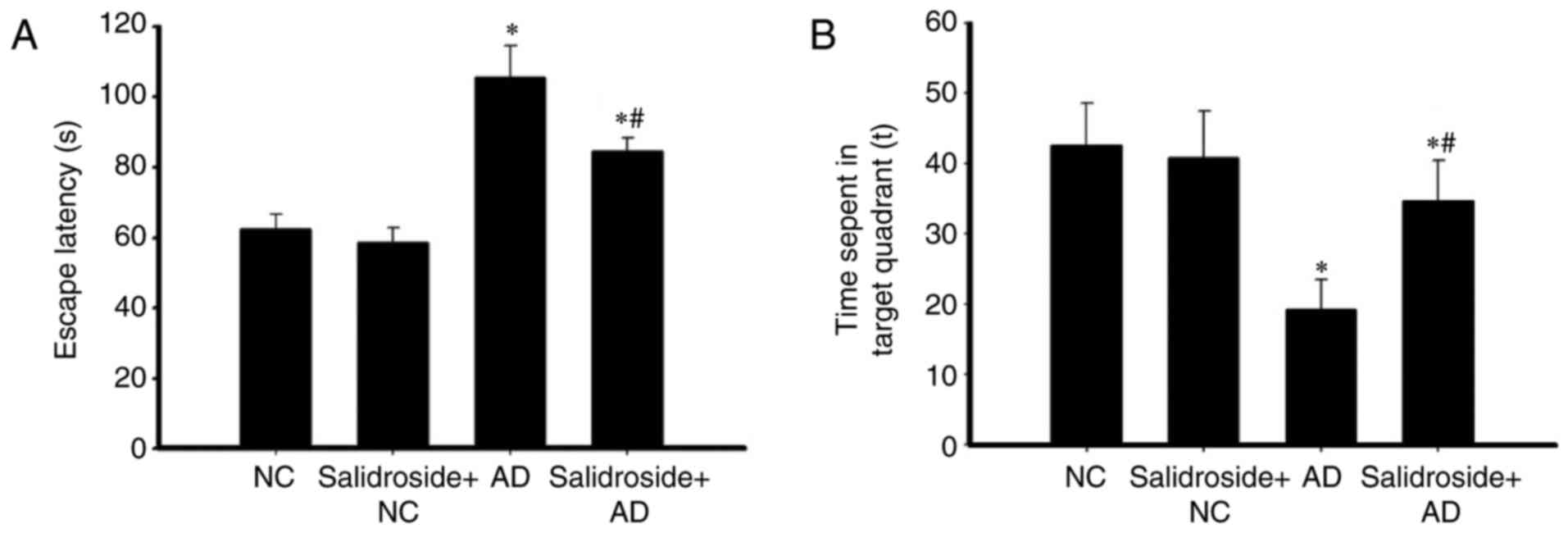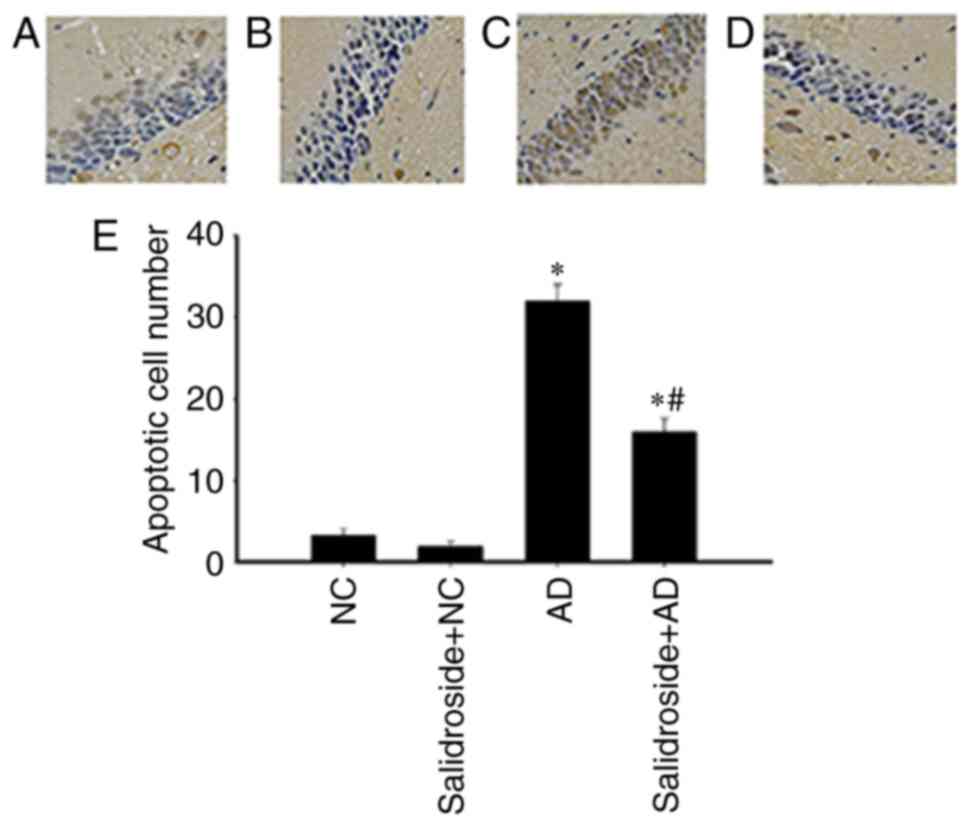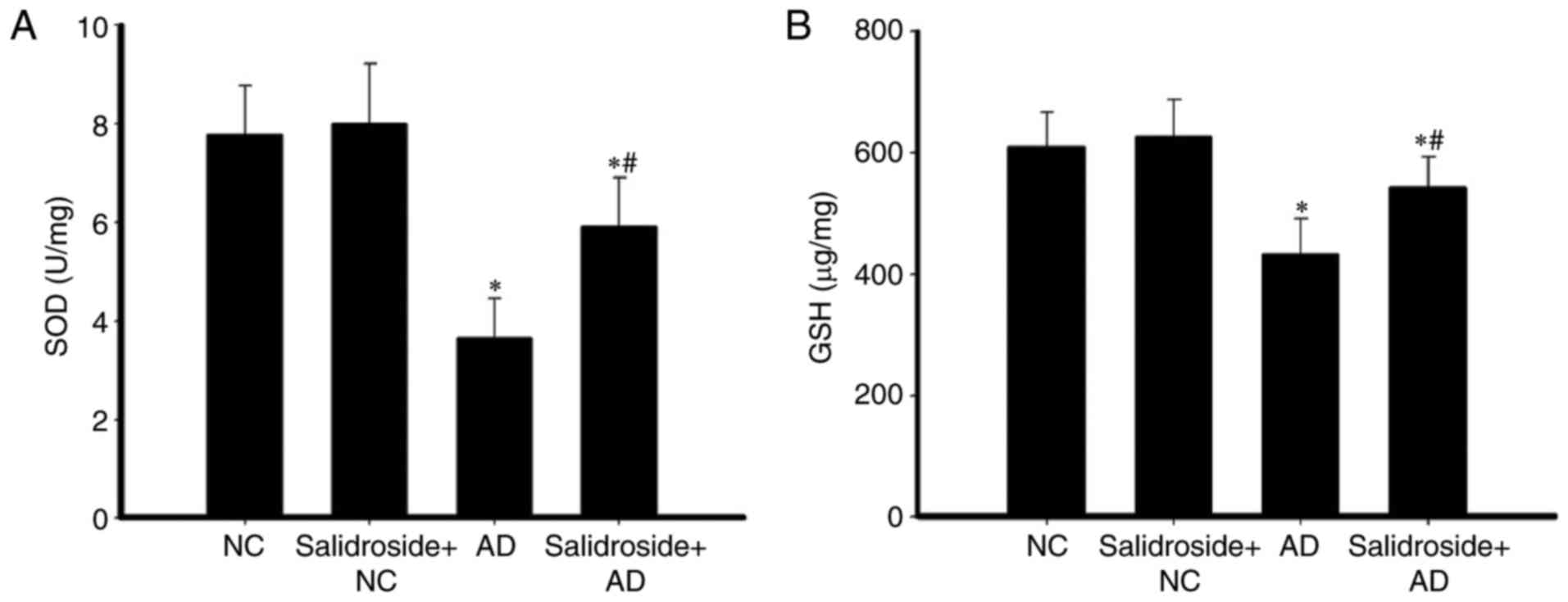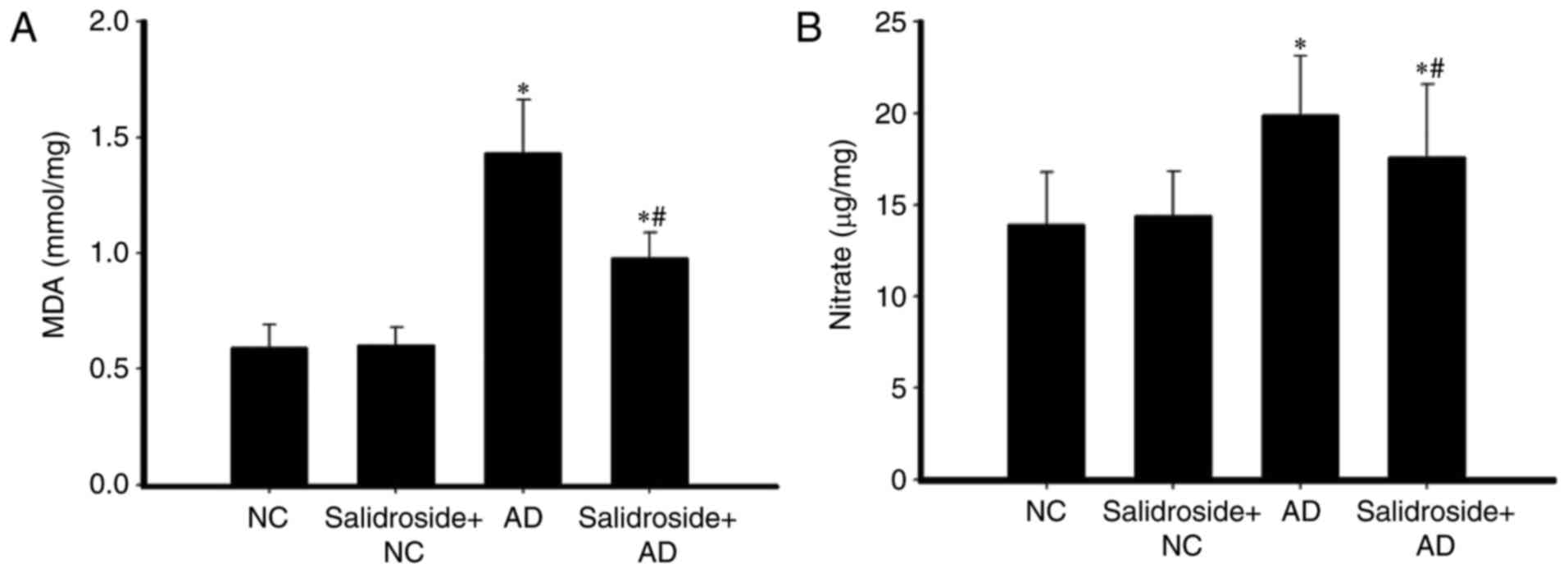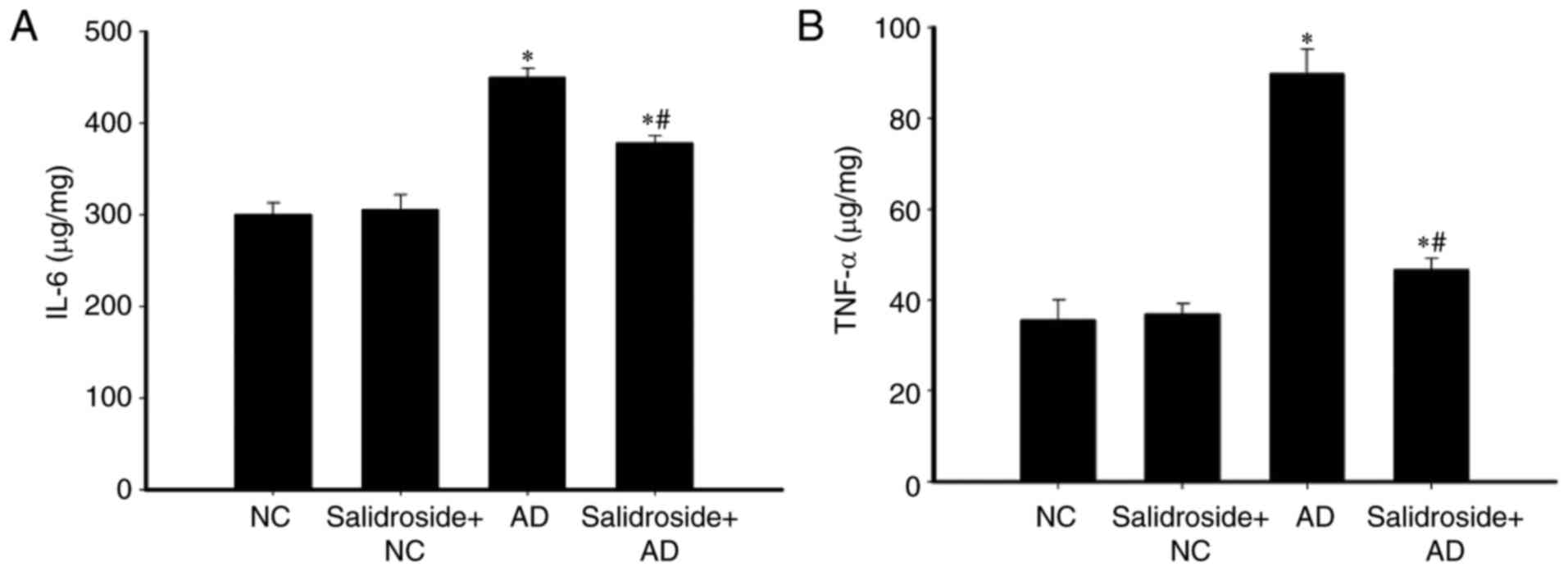|
1
|
Diwu YC, Tian JZ and Shi J: Effects of
Chinese herbal medicine Yinsiwei compound on spatial learning and
memory ability and the ultrastructure of hippocampal neurons in a
rat model of sporadic Alzheimer disease. Zhong Xi Yi Jie He Xue
Bao. 9:209–215. 2011. View Article : Google Scholar : PubMed/NCBI
|
|
2
|
Riley KP, Snowdon DA and Markesbery WR:
Alzheimer's neurofibrillary pathology and the spectrum of cognitive
function: Findings from the num study. Ann Neurol. 5:567–577. 2002.
View Article : Google Scholar
|
|
3
|
Gong CX, Liu F, Grundke-Iqbal I and Iqbal
K: Postranslational modifications of tau protein in Alzheimer's
disease. J Neural Transm. 6:813–838. 2005. View Article : Google Scholar
|
|
4
|
Moceri VM, Kukull WA, Emanual I, van Belle
G, Starr JR, Schellenberg GD, McCormick WC, Bowen JD, Teri L and
Larson EB: Using census data and birth certificates to reconstruct
the early-life socioeconomic environment and the relation to the
development of Alzheimer's disease. Epidemiology. 12:383–389. 2001.
View Article : Google Scholar : PubMed/NCBI
|
|
5
|
Iqbal K and Grundke-Iqbal I:
Metabolic/signal transduction hypothesis of Alzheimer's disease and
other tauopathies. Acta Neuropathol. 109:25–31. 2005. View Article : Google Scholar : PubMed/NCBI
|
|
6
|
Tuppo EE and Arias HR: The role of
inflammation in Alzheimer's disease. Int J Biochem Cell Biol.
37:289–305. 2005. View Article : Google Scholar : PubMed/NCBI
|
|
7
|
Yin Y, Liu Y and Huang L: Anti-apoptosis
effect of astragaloside Iv on Alzheimer's disease rat model via
enhancing the expression of Bcl-2 and Bcl-Xl. Scandinavian J Lab
Anim Sci. 37:75–82. 2010.
|
|
8
|
Chen Y, Tian Z, Liang Z, Sun S, Dai CL,
Lee MH, LaFerla FM, Grundke-Iqbal I, Iqbal K, Liu F and Gong CX:
Brain gene expression of a sporadic (icv-STZ Mouse) and a familial
mouse model (3×Tg-AD mouse) of Alzheimer's disease. PLoS One.
7:e514322012. View Article : Google Scholar : PubMed/NCBI
|
|
9
|
Javed H, Khan MM, Ahmad A, Vaibhav K,
Ahmad ME, Khan A, Ashafaq M and Islam F, Siddiqui MS, Safhi MM and
Islam F: Rutin prevents cognitive impairments by ameliorating
oxidative stress and neuroinflammation in rat model of sporadic
dementia of Alzheimer type. Neuroscience. 210:340–352. 2012.
View Article : Google Scholar : PubMed/NCBI
|
|
10
|
Zhang J, Liu A, Hou R, Zhang J, Jia X,
Jiang W and Chen J: Salidroside protects cardiomyocyte against
hypoxia-induced death: A HIF-1 α-activated and VEGF-mediated
pathway. Eur J Pharmacol. 607:6–14. 2009. View Article : Google Scholar : PubMed/NCBI
|
|
11
|
Fang D, Chen Y, Xu B, Ren K, He ZY, He LL,
Lei Y, Fan CM and Song XR: Development of lipid-shell and polymer
core nanoparticles with water-soluble salidroside for anti-cancer
therapy. Int J Mol Sci. 15:3373–3388. 2014. View Article : Google Scholar : PubMed/NCBI
|
|
12
|
Wang J, Li JZ, Lu AX, Zhang KF and Li BJ:
Anticancer effect of salidroside on A549 lung cancer cells through
inhibition of oxidative stress and phospho-p38 expression. Oncol
Lett. 7:1159–1164. 2014. View Article : Google Scholar : PubMed/NCBI
|
|
13
|
Li M, Dong C, Huai L, Bende T, Lihua S and
Ying W: Anti-fatigue effects of salidroside in mice. J Med Colleges
PLA. 23:88–93. 2008. View Article : Google Scholar
|
|
14
|
Zhu Y, Shi Y, Wu D, Ji YJ, Wang X, Chen
HL, Wu SS, Huang DJ and Jiang W: Salidroside protects against
hydrogen peroxide-induced injury in cardiac H9c2 cells via PI3K-Akt
dependent pathway. DNA Cell Biol. 30:809–819. 2011. View Article : Google Scholar : PubMed/NCBI
|
|
15
|
ZovkoKoncic M and Tomczyk M: New insights
into dietary supplements used in sport: Active substances
pharmacological and side effects. Curr Drug Targets. 14:1079–1092.
2013. View Article : Google Scholar : PubMed/NCBI
|
|
16
|
Wang H, Ding Y, Zhou J, Sun X and Wang S:
The in vitro and in vivo antiviral effects of
salidroside from Rhodiolarosea L. against coxsackie virus B3.
Phytomedicine. 16:146–155. 2009. View Article : Google Scholar : PubMed/NCBI
|
|
17
|
Vorhees CV and Williams MT: Morris water
maze: Procedures for assessing spatial and related forms of
learning and memory. Nat Protoc. 1:848–858. 2006. View Article : Google Scholar : PubMed/NCBI
|
|
18
|
Soslow RA, Dannenberg AJ, Rush D, Woerner
BM, Khan KN, Masferrer J and Koki AT: Cox-2 is expressed in human
pulmonary, colonic and mammary tumors. Cancer. 89:2637–2645. 2000.
View Article : Google Scholar : PubMed/NCBI
|
|
19
|
Realdon O, Rossetto F, Nalin M, Baroni I,
Cabinio M, Fioravanti R, Saibene FL, Alberoni M, Mantovani F,
Romano M, et al: Technology-enhanced multi-domain at home continuum
of care program with respect to usual care for people with
cognitive impairment: The Ability-TelerehABILITation study protocol
for a randomized controlled trial. BMC Psychiatry. 16:4252016.
View Article : Google Scholar : PubMed/NCBI
|
|
20
|
Liu S, Yu X, Hu B, Zou Y, Li J, Bo L and
Deng X: Salidroside rescued mice from experimental sepsis through
anti-inflammatory and anti-apoptosis effects. J Surg Res.
195:277–283. 2015. View Article : Google Scholar : PubMed/NCBI
|
|
21
|
Díaz Lanza AM, Abad Martínez MJ, Fernández
Matellano L, Recuero Carretero C, Villaescusa Castillo L, Silván
Sen AM and Bermejo Benito P: Lignan and phenylpropanoid glycosides
from Phillyrealatifolia and their in vitro anti-inflammatory
activity. Planta Med. 67:219–223. 2001. View Article : Google Scholar : PubMed/NCBI
|
|
22
|
Qu ZQ, Zhou Y, Zeng YS, Lin YK, Li Y,
Zhong ZQ and Chan WY: Protective effects of a rhodiola crenulata
extract and salidroside on hippocampal neurogenesis against
streptozotocin-induced neural injury in the rat. PLoS One.
7:e296412012. View Article : Google Scholar : PubMed/NCBI
|
|
23
|
Kimura T, Hong Nguyen PT, Ho SA, Tran AH,
Ono T and Nishijo H: T-817MA, a neurotrophic agent, ameliorates the
deficits in adult neurogenesis and spatial memory in rats infused
i.c.v. with amyloid-β peptide. Br J Pharmacol. 157:451–463. 2009.
View Article : Google Scholar : PubMed/NCBI
|
|
24
|
Palop JJ and Mucke L: Amyloid-beta-induced
neuronal dysfunction in Alzheimer's disease: From synapses toward
neural networks. Nat Neurosci. 13:812–818. 2010. View Article : Google Scholar : PubMed/NCBI
|
|
25
|
Arber CE, Li A, Houlden H and Wray S:
Review: Insights into molecular mechanisms of disease in
neurodegeneration with brain iron accumulation: Unifying theories.
Neuropathol Appl Neurobiol. 42:220–241. 2016. View Article : Google Scholar : PubMed/NCBI
|
|
26
|
Zhao Y and Zhao B: Oxidative stress and
the pathogenesis of alzheimer's disease. Oxid Med Cell Longev.
2013:3165232013. View Article : Google Scholar : PubMed/NCBI
|
|
27
|
Pencea V, Bingaman KD, Wiegand SJ and
Luskin MB: Infusion of brain-derived neurotrophic factor into the
lateral ventricle of the adult rat leads to new neurons in the
parenchyma of the striatum, septum, thalamus and hypothalamus. J
Neurosci. 21:6706–6717. 2001.PubMed/NCBI
|
|
28
|
Kudin AP, Bimpong-Buta NY, Vielhaber S,
Elger CE and Kunz WS: Characterization of superoxide-producing
sites in isolated brain mitochondria. J Biol Chem. 279:4127–4135.
2004. View Article : Google Scholar : PubMed/NCBI
|
|
29
|
Calvert JW, Yin W, Patel M, Badr A,
Mychaskiw G, Parent AD and Zhang JH: Hyperbaric oxygenation
prevented brain injury induced by hypoxia-ischemia in a neonatal
rat model. Brain Res. 951:1–8. 2002. View Article : Google Scholar : PubMed/NCBI
|
|
30
|
Ferguson-Smith AC, Chen YF, Newman MS, May
LT, Sehgal PB and Ruddle FH: Regional localization of the
interferon-beta 2/B-cell stimulatory factor 2/hepatocyte
stimulating factor gene to human chromosome 7p15-p21. Genomics.
2:203–208. 1988. View Article : Google Scholar : PubMed/NCBI
|
|
31
|
van der Poll T, Keogh CV, Guirao X,
Buurman WA, Kopf M and Lowry SF: Interleukin-6 gene-deficient mice
show impaired defense against pneumococcal pneumonia. J Infect Dis.
176:439–444. 1997. View
Article : Google Scholar : PubMed/NCBI
|
|
32
|
Hotamisligil GS, Shargill NS and
Spiegelman BM: Adipose expression of tumor necrosis factor-alpha:
Direct role in obesity-linked insulin resistance. Science.
259:87–91. 1993. View Article : Google Scholar : PubMed/NCBI
|
|
33
|
Tateya S, Kim F and Tamori Y: Recent
advances in obesity induced inflammation and insulin resistance.
Frontiers Endocrinol (Lausanne). 4:932013.
|



